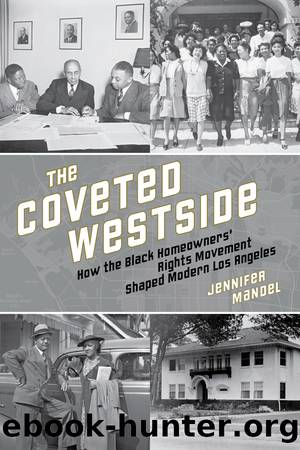The Coveted Westside by Mandel Jennifer;

Author:Mandel, Jennifer; [Mandel, Jennifer]
Language: eng
Format: epub
Publisher: University of Nevada Press
THE WATTS REBELLION
What began as a drunk driving arrest of a twenty-one-year-old African American man on a hot summer evening in Watts sparked a six-day-long rebellion throughout the central city. On August 11, 1965, near the Watts border at 116th Street and Avalon Boulevard, Lee Minikus, a White California highway patrol officer on a motorcycle, pulled over Marquette Frye who was driving his motherâs 1955 Buick. After Frye failed a sobriety test, the officer arrested him for driving under the influence. Fryeâs twenty-two-year-old stepbrother, Ronald Frye, then stepped out of the vehicle; Minikus radioed his partner, who arrived with a car to take Frye to jail, and Ronald went to get Fryeâs mother, Rena Price, who came from her home two blocks away. Meanwhile, a small group of onlookers outside in the summer heat had swelled to some 250 to 300 people. They had cause for their anger. Added to the countless, long-standing systemic racist policies and practices that kept Angelenos of color hemmed in in the Eastside, Chief William H. Parkerâs Los Angeles Police Department had gained notoriety for its relentless brutality targeted at African Americans, and, at that moment, the Frye brothers, their mother, and the crowd confronted it. As the crowd grew angry, which by then had grown to a thousand bystanders, the officers detained Marquette, Ronald, and Rena, and took them to the police station. Reports of police abuse of power at the scene subsequently spread throughout greater Los Angeles and sparked a nearly weeklong protest.67
Once a thriving, multiracial, blue-collar community, Watts had become mostly populated by Blacks. Incorporated first as a self-governing city in 1907 and then part of Los Angeles after 1926, Watts developed alongside the construction of two major rail lines. Mexican laborers mostly working on the railroad at the turn of the century initially settled around the tracks, followed by a small number of African Americans in a section of the city known as Mudtown. In the first quarter of the twentieth century, Watts grew into a working-class enclave with affordable housing, a reliable mass transit system, and a multiracial population made up of Blacks, Whites, Asians, and Latinos. World War II brought employment opportunities and an influx of African Americans to the city, but the subsequent years wreaked havoc on the quaint community. Watts became part of Los Angelesâs neglected and isolated Black belt that had dilapidated housing, no rent control, exploitative landowners, and a high rate of homelessness. The passage of Proposition 14 represented and added to the decades of discrimination, neglect, and isolation that many African Americans had felt. A constant succession of social, economic, and political developments devastated the enclave. Deindustrialization, high Black unemployment, the decline of labor unions, the loss of public transportation, persistent housing discrimination, city officialsâ neglect of antipoverty programs and indifference to local grievances, the rise of gangs, unapologetic police brutality, anti-Communism and the suppression of liberalism, and the rise of Black nationalism set the stage for the 1965 uprising that started on the Eastside, or what became known as South Central, and, later, South Los Angeles.
Download
This site does not store any files on its server. We only index and link to content provided by other sites. Please contact the content providers to delete copyright contents if any and email us, we'll remove relevant links or contents immediately.
| Africa | Americas |
| Arctic & Antarctica | Asia |
| Australia & Oceania | Europe |
| Middle East | Russia |
| United States | World |
| Ancient Civilizations | Military |
| Historical Study & Educational Resources |
Machine Learning at Scale with H2O by Gregory Keys | David Whiting(4183)
Never by Ken Follett(3794)
Fairy Tale by Stephen King(3220)
The Man Who Died Twice by Richard Osman(2997)
Oathbringer (The Stormlight Archive, Book 3) by Brandon Sanderson(2886)
Will by Will Smith(2793)
Rationality by Steven Pinker(2291)
The Dark Hours by Michael Connelly(2245)
Can't Hurt Me: Master Your Mind and Defy the Odds - Clean Edition by David Goggins(2228)
The Dawn of Everything: A New History of Humanity by David Graeber & David Wengrow(2122)
Friends, Lovers, and the Big Terrible Thing by Matthew Perry(2119)
Principles for Dealing With the Changing World Order: Why Nations Succeed and Fail by Ray Dalio(1974)
HBR's 10 Must Reads 2022 by Harvard Business Review(1777)
A Short History of War by Jeremy Black(1762)
Go Tell the Bees That I Am Gone by Diana Gabaldon(1687)
515945210 by Unknown(1599)
A Game of Thrones (The Illustrated Edition) by George R. R. Martin(1589)
Kingdom of Ash by Maas Sarah J(1527)
443319537 by Unknown(1470)
